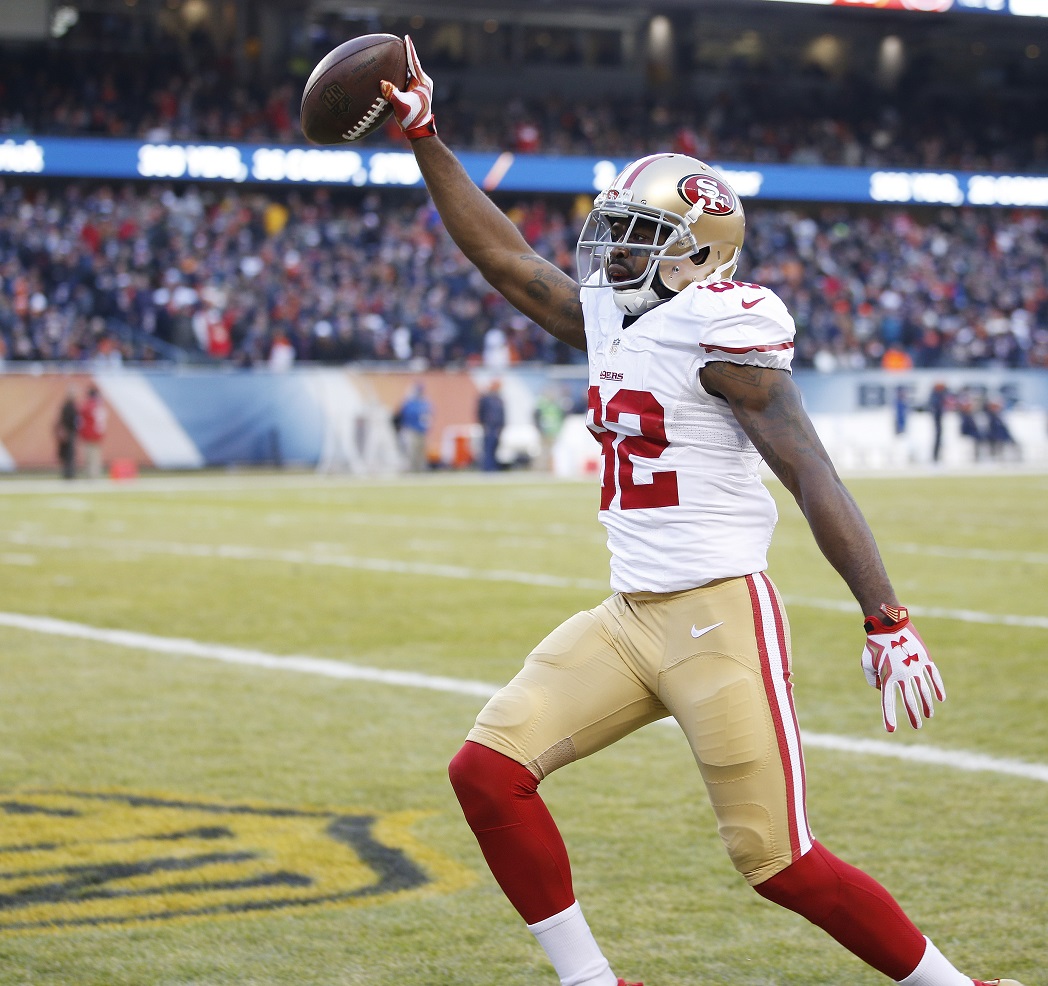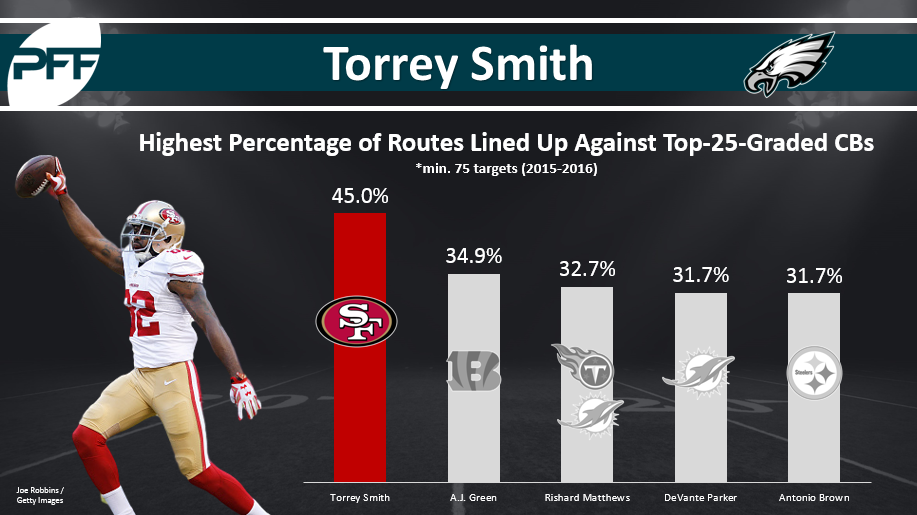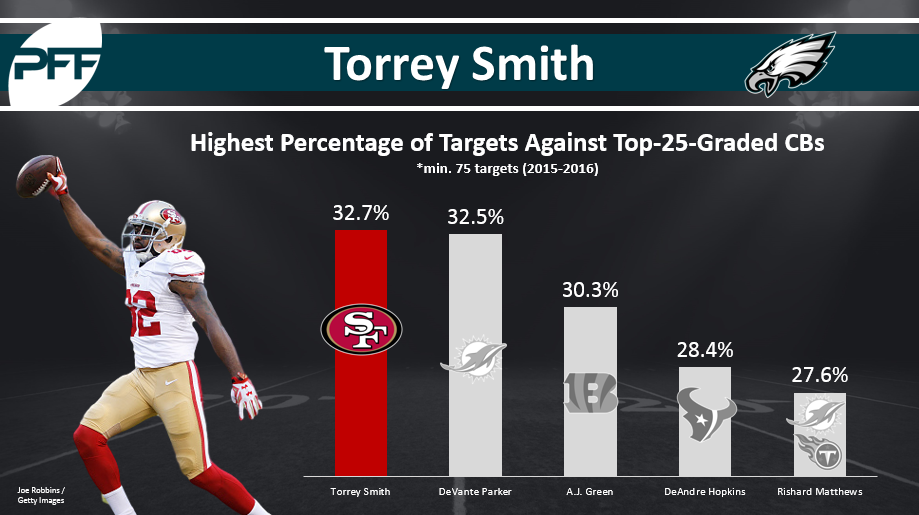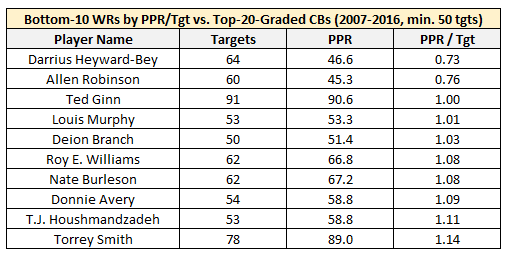(“Metrics that Matter” is a short feature that appears every Tuesday, Wednesday, and Saturday, highlighting a notable fantasy lesson to be learned from PFF’s advanced stats.)
One of the perks of being a full-time fantasy analyst (man, I love saying that) is that I’ve become skilled at being able to argue, in a compelling manner, either side to any debate. Using any number of statistics, I really feel like I can argue the pros or cons of nearly any player in fantasy football. The great Matthew Berry constantly warns (in his annual “100 Facts” article) of how easy it is to manipulate data to produce an intended result. This is why my position goes beyond just being a fantasy/NFL sabermetrician. I must also give sound well-reasoned advice.
One player I imagined it would be hard to argue in favor of is Torrey Smith. I mean, I was never particularly high on him, so I haven’t been compelled to, but sometimes you find the stats – and sometimes the stats find you. After uncovering the following few statistics, I’m much more bullish on Smith’s prospects in Philadelphia.
Over the past two seasons, during his time in San Francisco, no wide receiver (of 103 qualifying) has run a higher percentage of his routes against top-25-graded cornerbacks (by each season) than Smith (45.0 percent). The next-closest wide receiver (A.J. Green) ran only 34.9% of his routes against top-25-graded cornerbacks.
Over the past two seasons, Smith saw 32.7 percent of his targets against top-25-graded cornerbacks. No receiver saw a higher percentage of his targets against top-25-graded cornerbacks over this stretch.
For perspective, in 2014 with Baltimore, only 11.2 percent of his targets came against top-25-graded cornerbacks, which ranked 60th-highest of all 83 wide receivers to see at least 50 targets that season. He lined up against top-25-graded cornerbacks on only 11.6 percent of the time, which ranked 10th-lowest of 84 qualifying.
Part of Smith’s difficult cornerback schedule over the past two seasons had to do with playing in the NFC West against Richard Sherman’s Seahawks and Patrick Peterson’s Cardinals. Part of this also had to do with Chip Kelly's usage of Smith. Last season he ran 75.6 percent of his routes from the right wide receiver position. The next-closest player (Terrance Williams) ran only 53 percent of his routes from the right wide receiver position. Opposite Smith, Quinton Patton isn't exactly an imposing threat for opposing defenses. So knowing Smith wouldn’t be moved around the line of scrimmage very often (or schemed open), this made things easier for opposing defenses. Put your best defender on Smith and let the 49ers try to beat you with short passes to the slot (Jeremy Kerley, 108 targets.)
It’s not just that Smith had a very difficult cornerback schedule during his time in San Francisco, but he was also especially ineffective against elite cornerbacks. When lined up against top-25-graded cornerbacks over the past two seasons, he averaged 0.14 fantasy points per route run. Against all other cornerbacks, he doubled that, averaging 0.28 fantasy points per route run. This has been a theme throughout his career. Over the past decade, only nine wide receivers (of 106 qualifying) with at least 50 targets against top-20-graded cornerbacks (in each season) averaged fewer fantasy points per target than Smith (1.14.)
(No, that’s not a mistake. Allen Robinson does in fact rank second-worst. I’ve written about my disdain for his current ADP elsewhere.)
I asked PFF NFL Analyst Mike Renner for his thoughts on these statistics. He thinks Smith was partly dealt a bad hand in that there wasn't much receiving talent in San Francisco outside of him, and Kelly keeping him locked in at right wide receiver certainly didn't help. Still, he doesn’t think Smith profiles as a true WR1. He’s “more of a one-trick pony” in that wins on the deep ball with speed and lacks polish as a route runner. Top cornerbacks are less likely to fall victim to this one trick, and like I tried to show in my last article, oftentimes for wide receivers, “speed negates speed.”
What does this mean for fantasy?
Nelson Agholor was our worst-graded wide receiver in each of the past two seasons, and will likely not be a starter this season. Jordan Matthews projects to move back to the slot full-time (where he ran 92 percent of his routes 2014-2015.) The addition of Alshon Jeffery (who profiles more as a true WR1) will surely command the bulk of the targets in Philadelphia, but will also help draw top cornerbacks away from Smith.
Prior to his time in San Francisco, Smith finished as a top-30 fantasy wide receiver in each of his first four seasons. In 2015, believe it or not, Smith led all wide receivers with at least 50 targets in yards per target average (11.8.) He’s currently being drafted as the 83rd wide receiver off the board in MFL10 best-ball leagues. In that format, where boom-or-bust players are more of an advantage, he’s certainly a value. He’s also worth looking at in the last few rounds of your redraft leagues as well, but likely should not be given high priority.
My main takeaway from this is to target Smith in DFS during weeks Jeffery is projected to draw top coverage while Smith looks to run the majority of his routes against less-talented or slower (Smith ran a 4.43-second 40-yard dash at his combine in 2011) cornerbacks.






 © 2025 PFF - all rights reserved.
© 2025 PFF - all rights reserved.